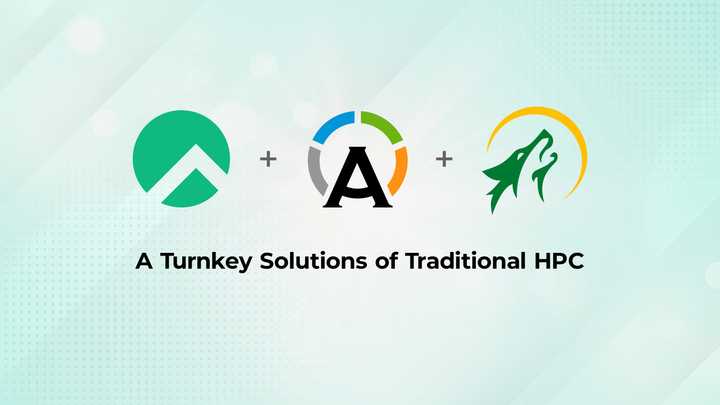Rocky Linux, Warewulf, and Apptainer for Turnkey Solutions

Pulling together proven technology and the latest innovations, CIQ has created a turnkey solution with a traditional high performance computing (HPC) stack that meets the needs of a large variety of users. Easy to deploy, highly scalable, and very flexible, this infrastructure substrate provides a stable, secure, and supported foundation, empowering users to build the systems and tools to create what they need and solve their problems.
So what exactly do you unlock and access with the CIQ stack for traditional HPC? In a recent webinar with Gregory Kurtzer (founder of Rocky Linux, Singularity/Apptainer, Warewulf, CentOS, and the CEO of CIQ) and Robert Adolph (Chief Product Officer at CIQ), we broke down the basics.
CIQ and HPC
Traditional HPC refers to tightly coupled applications and an architecture that is designed to optimally benefit applications of that type. For the past 28 years, the Beowulf architecture has been the foundation for building parallel computing clusters. And now, the CIQ team is leveraging their expertise in traditional HPC, along with cloud and hyperscale, to enable the next generation of HPC.
CIQ’s turnkey solution operates across bare metal to multi-cloud environments. As an open source project, the HPC stack has been developed and refined through collaboration with the community.
CIQ’s traditional HPC stack
The three major components of a high performance computing system are: 1) provisioning, 2) a base-operating system running the resource, and 3) containers. Here’s how CIQ’s solutions form that integrated HPC stack:
-
Provisioning: To build an HPC cluster, or any cluster, you need to make a whole group of computer systems work together collaboratively to solve a software problem. The larger the cluster, the more of a challenge it is, requiring a variety of tools to provision the operating systems, resources, and management of that cluster. In 2001, Kurtzer created Warewulf, a cluster provisioning solution that offers both ease of use and scalability. With Warewulf, we are able to build high performance computing systems from the software perspective.
One of its biggest features is the ability to provision stateless compute images or nodes at scale. That means that you could have racks of hundreds or even thousands of servers, roll them up into the data center, give them power, hook them up to the network, and start turning on nodes– without having to install or configure them. From the moment the hardware is set up, you can have the whole operating system built and ready to run in an hour or two. Warewulf uses node images to make this possible: previously, it used virtual node file systems, or chroots, but the latest version leverages containers. This centralized, flexible, and easy to integrate solution is continuing to grow in functionality and popularity. Currently, around 50% of the top 500 systems are running Warewulf with preconfigured containers or custom images.
-
Base-operating system: Rocky Linux is an open source operating system that is stepping up as the successor to CentOS (originally created by Kurtzer and Rocky McGaugh). CentOS is used on 20-25% of all enterprise resources, cloud instances, and containers worldwide–and that number skyrockets to 70-75% in high performance computing, but Rocky is rapidly being adopted as its replacement. Fully compatible with Enterprise Linux, it is also incredibly compatible with high performance computing applications and solutions.
As a replacement, Rocky Linux promises to be better than CentOS, because it will remain community-based, rather than controlled by a single company. CIQ is the official founding partner of the Rocky Linux project, but it is only one of many companies that are helping, sponsoring, and partnering with the Rocky Enterprise Software Foundation. Our goal is simply to bring value to customers with support and services.
-
Containers: Apptainer started life as Singularity, which has been the dominant market share leader of containers within HPC. Created by Kurtzer as a direct, HPC-tailored response to Docker, it enables the integration of containers into an HPC system, and has become a prevalent and critical piece of high performance computing infrastructure. When containers were starting to evolve and gain traction, publicity, and interest in the enterprise and cloud space, the methods for dealing with the run time for containers was very root-centric. With a Beowulf-style architecture, hundreds or thousands or users couldn’t gain access to a container subsystem that was running on root in a secure manner, since they would also gain the ability to control the host operating system. Apptainer is therefore a container system that is designed to be used by non-privileged users in a shared system. Unlike a traditional container ecosystem, Apptainer has single file-based containers that can be cryptographically signed and encrypted, raising the level of security even higher.
To ensure that it remains open source and in the community, Singularity was renamed as Apptainer, and is now maintained by the Linux Foundation. This move also allows for better cross-pollination between the high performance computing world and the enterprise and cloud world, in terms of container and container infrastructure.
A turnkey solution
Vendors and customers want a turnkey solution: they want to come to a single location, get the entire foundation of what they want to build, and know that it can be integrated and supported easily. CIQ is providing that solution with its traditional HPC stack, designed for ease of use, scalability, and flexibility, so it can be a base foundation for HPC centers, HPC consumers, and even enterprises that are looking at doing compute-focused workflows. We’ve democratized the architecture to make it possible for anybody to build an OpenHPC cluster or a custom cluster. Each component is available à la carte as building blocks, or you can use our whole stack, depending on your needs.
To learn more specifics about the HPC stack, what developments are in the works (like imaging-as-a-service and repo-as-a service), and our support offerings, you can watch the entire webinar here.


